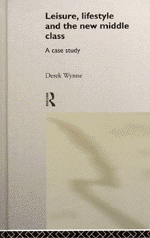

![]()
![]()

The research involved observation, interviews and a questionnaire administered to the residents of the estate which is a newly built residential development in Mid-Cheshire. The Heath, Wynne argues, is an example of a new housing development that is marketed towards parents who want to raise their children in the countryside rather than the city. The author found that the male residents were in a variety of professional and managerial occupations while their partners were to be found in the semi-professions and clerical work. They had different levels of education since the professionals usually had degrees while the managers enjoyed promotion in work. Wynne distinguishes between four groups, those of working-class origin with low levels of education, those of working-class origin with high levels of education, those of middle-class origin with low levels of education and those of middle-class origin with high levels of education. Varying routes into different occupations, therefore, highlight the heterogeneity of the new middle class.
Against this background, Wynne demonstrates that the life-styles of the different fragments of the middle class vary with successive chapters on sociability and leisure, the division of labour and the use of the clubhouse on the estate. A sharp contrast, for example, is drawn between the cultural practices of the uneducated socially mobile working-class men who confine themselves to propping up the bar of the clubhouse in the early evening as against the sporting activities of the educated middle class. Education is the key to different leisure and life-styles.
This argument is in line with current thinking on the middle classes but herein lies a problem with the book. Wynne does not consider the similarities between these class fragments including the fact that the majority of the residents did not use the communal facilities at all. Similarly, he says nothing about the shared decision to move to a residential development like The Heath. Did the professional and managerial middle classes - most of whom came from the North West - share an aspiration to raise their children in the countryside rather than the working-class cities of Liverpool and Manchester? They might, in other words, have had much in common.
Wynne overreaches himself towards the end of the book. He suggests that his findings confirm the emergence of a postmodern culture and an increasing individualization of the social structure.
It is not entirely clear why the cultural practices of the new middle class - with a mix of working-class and middle-class habits - can be described as postmodern. Maybe this problem arises because it is not clear what a postmodern life-style is other than what everybody does these days! Similarly, the findings on leisure do not necessarily support the individualization thesis. Wynne is keen to adopt a post-structuralist stance and emphasize the importance of choice in lifestyles. Arguably, what his research actually shows is that more sophisticated categories can tell us much about leisure and life-styles. That said, his finding about the importance of education as a source of cultural differentiation is important, and the ways in which education affects the domestic division of labour, leisure activities and so forth should be explored further in the analysis of class.
These comments suggest that Wynne could have been a bit more cautious about the extent to which his empirical findings contribute to theoretical debates about the cultural reproduction of the middle classes. Maybe throwing some caution to the wind, however, is what makes this book an engaging and enjoyable read (especially when Wimbledon tickets for `finals day' are won by the `drinkers' rather than the `sporters'!). After all, it demonstrates how recent theoretical discussion about cultural distinctions and practices has much to offer the sub-discipline of `class analysis'. It also offers us an excellent case study of the middle class with a real contemporary feel to it. Academic staff should read this book and encourage their students to do so as well. I only hope the production of a hardback rather than a paperback edition does not deter libraries from purchasing the book to ensure the wide readership it deserves.
Fiona Devine
University of Manchester